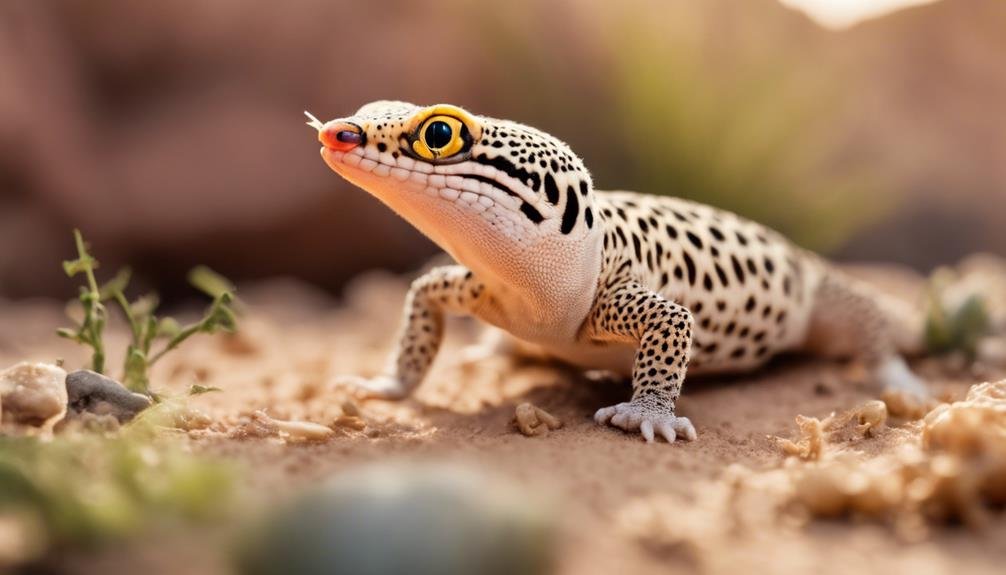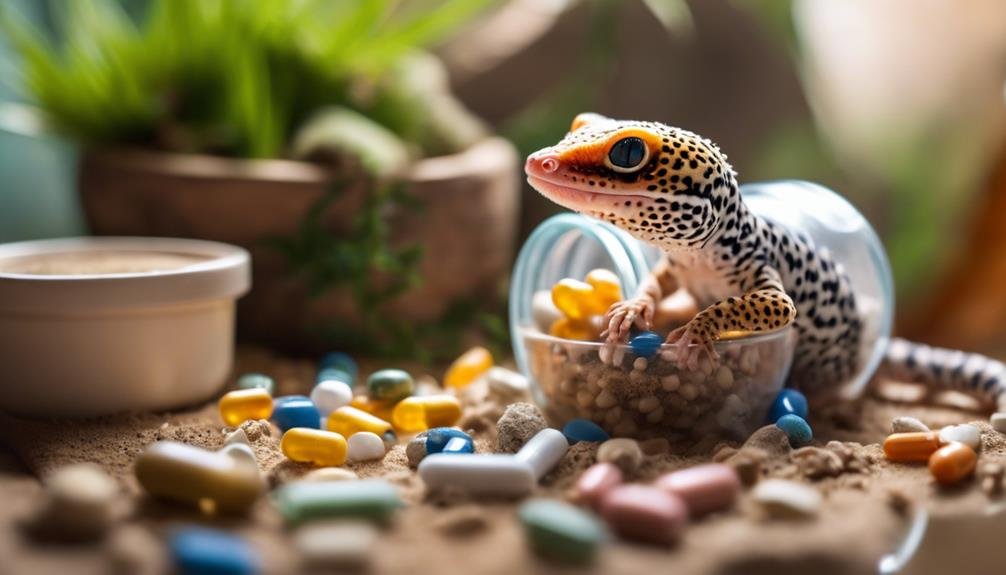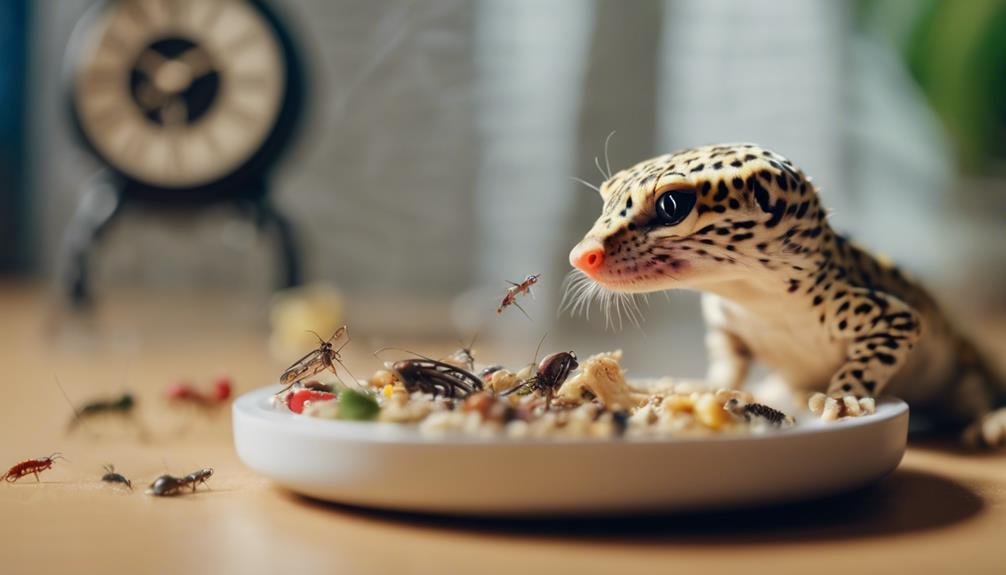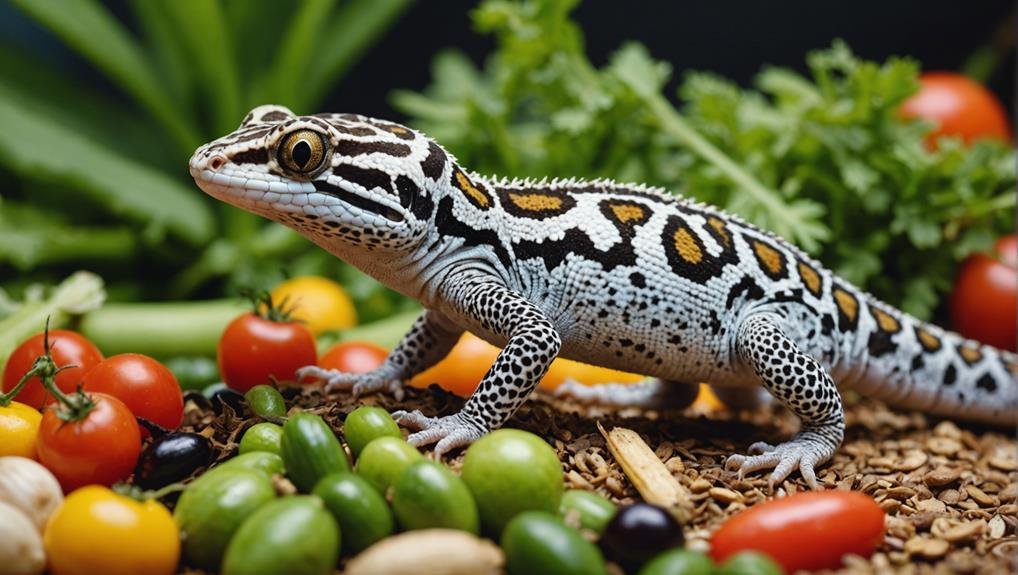When considering what to feed your leopard gecko, you’ll quickly discover that various insects are essential for their health. Dubia roaches, black soldier fly larvae, and crickets provide the best nutrition they need. But did you know that gut-loading these insects with nutritious foods can greatly enhance the benefits your gecko receives? And that’s not all—calcium and multivitamin supplements play an important role in ensuring a balanced diet. So, how do you navigate the complexities of feeding frequency and the dangers of unsafe foods?
Key Takeaways
- Dubia roaches offer high nutritional value and are preferred over crickets.
- Gut-loading insects with leafy greens and fruits boost gecko health.
- Use calcium and multivitamin powders to prevent nutritional deficiencies.
- Avoid feeding wild-caught or toxic insects like hornworms.
- Adjust feeding frequency: daily for hatchlings, every other day for juveniles, and twice weekly for adults.
Essential Insects for Leopard Geckos


When feeding your leopard gecko, choosing the right insects is essential for their health and well-being. Dubia roaches are excellent feeder insects, offering high nutritional value. They’re packed with protein and are easy to digest, making them a top choice for your gecko’s diet.
While readily available, superworms should be used sparingly due to their high-fat content. Including them in a varied diet can keep your leopard gecko interested in its meals.
Black soldier fly larvae, also known as BSFL or Nutrigrubs, are another fantastic option. They’re rich in calcium, vital for your gecko’s bone health. When dusted with calcium powder, these larvae become an even more potent source of nutrition.
Mealworms, although popular, should comprise less than 25% of your gecko’s diet because they’ve lower nutrient content and high chitin levels, which can be hard to digest.
Crickets can also be included but shouldn’t be the primary food due to their lower nutritional value than roaches. By offering a variety of feeder insects, you ensure your leopard gecko receives a balanced and nutritious diet.
Importance of Gut Loading
Gut-loading feeder insects before offering them to your leopard gecko greatly enhances the nutritional value of their diet. When you gut load, you fill the insects with nutritious foods, ensuring ideal nutrition transfer to your gecko when they eat these insects. This process is essential because it boosts your leopard gecko’s overall health and vitality.
To achieve this, feed the insects healthy foods like leafy greens, fruits, and grains. These nutritious items fortify the insects, making them a more wholesome meal for your gecko.
Commercial gut load diets like Repashy SuperLoad offer a convenient and balanced option. These specially formulated diets are designed to maximize the nutritional content of the feeder insects, ensuring your leopard gecko gets the best possible nutrition.
Role of Supplements


To complement the benefits of gut loading, incorporating supplements like calcium powder into your leopard gecko’s diet is essential for their overall health. Calcium powder is important for maintaining a proper calcium-phosphorus balance, which helps prevent metabolic bone disease. Dusting your gecko’s food with calcium powder guarantees they receive the nutrients for strong bones and proper muscle function.
In addition to calcium, using a multivitamin powder can provide essential nutrients that might be missing from your gecko’s regular diet. These powders often include vitamins A, B, and E, crucial for your gecko’s immune system and overall well-being.
All-in-one powders are another great option, offering a balanced mix of essential nutrients in one convenient package. These can simplify your supplementation routine and ensure your gecko receives a thorough nutritional profile.
If your gecko has UVB lighting, they’ll require less D3 in their diet, as UVB exposure helps synthesize vitamin D3 naturally. However, for geckos without UVB lighting, it’s important to frequently include D3 in their dietary supplements to aid calcium metabolism.
Proper supplementation is key to preventing nutritional deficiencies and maintaining your leopard gecko’s health.
Unsafe Foods for Leopard Geckos
Feeding your leopard gecko the wrong foods can lead to serious health issues and should be avoided at all costs. Wild-caught insects seem natural but can expose your gecko to diseases and pesticides. Stick to commercially bred insects for your leopard gecko to guarantee they receive every essential mineral without the risk.
Toxic insects, such as hornworms, are particularly dangerous and can be fatal. Never feed these to your geckos. Additionally, avoid dead, dried, or processed foods. These lack the nutritional value your leopard gecko needs and can lead to deficiencies. Fresh, live prey is crucial for their best nutrition, providing the necessary proteins and vitamins.
Avoiding any toxic foods, including poisonous plants or insects, is also important. Even a small amount can be harmful. By carefully selecting safe insects for your leopard gecko, you ensure they receive a balanced diet of essential minerals and nutrients.
Feeding Frequency and Amount


When deciding how often and how much to feed your leopard gecko, age and size are important in determining their dietary needs. Hatchlings should be fed daily to support their rapid growth. Juveniles, on the other hand, should be fed every other day as their growth rate slows down. For subadults and adult Leopard Geckos, feeding twice per week is sufficient. Adjust the feeding frequency and amounts based on your gecko’s age and size to maintain the best health.
When you offer your Leopard Gecko food, provide as much as they can eat within 10-15 minutes if you’re using a bowl. If you prefer feeding with tongs, let them eat as many insects as they want. Remember, variety is key to ensuring that geckoes receive all necessary nutrients.
Adult Leopard Geckos have different dietary requirements than hatchlings and juveniles. Therefore, it is important to understand what your leopard geckos need at each stage of their lives. By observing your gecko and adjusting their feeding schedule accordingly, you can help them thrive. Keep an eye on their weight and overall health, making changes as necessary to meet their evolving needs.
Conclusion
To keep your leopard gecko happy and healthy, focus on providing essential insects like Dubia roaches, black soldier fly larvae, and crickets.
Don’t forget to gut load these insects with nutritious foods and regularly use calcium and multivitamin supplements.
Avoid feeding your gecko toxic or wild-caught prey to guarantee their safety.
Adjust feeding frequency and amounts based on their age and size, and your pet will thrive and be well-nourished.


